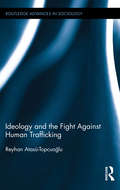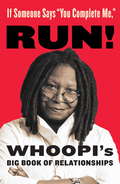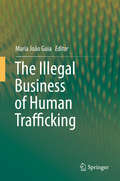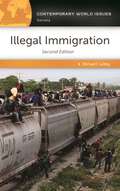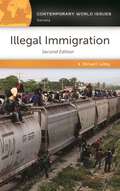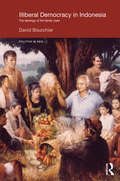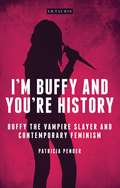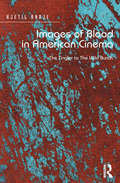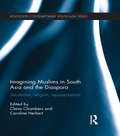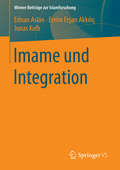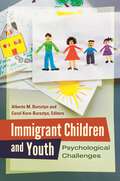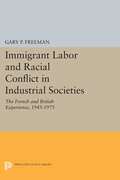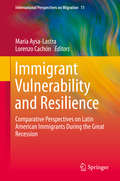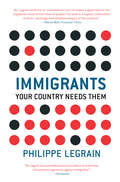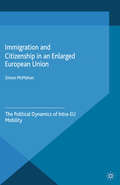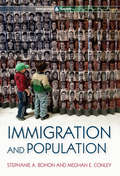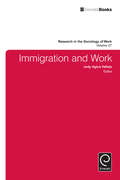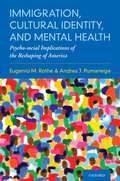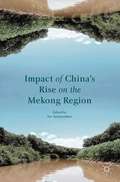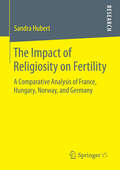- Table View
- List View
Ideology and the Fight Against Human Trafficking (Routledge Advances in Sociology)
by Reyhan Atasü-TopcuoğluHuman trafficking has become one of the most spoken-of problems of our day, and fighting it has grown into a multi-million-dollar project sector. This book is about how we all come to name various exploitative migratory experiences "human trafficking" and how we build a consensus on how to counter it. This book investigates counter-trafficking as a transnational field and tries to show how connected stances against a "global social problem" are produced internationally in general, and nationally in particular within the example of three countries which are defined with different positions according to the phenomenon: Ukraine as a "source country," Turkey as a "transit and destination country," Germany as a "destination country." The book examines how power relations limit the language to propose and solve social problems in the example of human trafficking. It shows the limits of scientific studies on the issue and the chasm between counter-trafficking and its primary target group, the trafficked people.
If Someone Says "You Complete Me," Run!: Whoopi’s Big Book Of Relationships
by Whoopi GoldbergFrom bestselling author, household name and host of The View, Whoopi Goldberg, comes the perfect antidote for all those relationship advice books in the world.Whoopi Goldberg has been an electrifying, envelope-pushing public figure of many stripes: acclaimed actor, comedienne, singer, songwriter, author, political activist and talk show host. Now, Whoopi will speak openly about why marriage isn't for everyone, how being alone can be satisfying, and how what's most important is understanding who you are and what makes you happy. Wise, funny, and conversation-starting, Whoopi's message is sure to resonate with the millions of people who struggle with relationships every day. Whoopi says: I get to hear from a lot of different people about relationships and this got me trying to figure out why the divorce rate is so high. It occurred to me that as one who has done it badly often, I might have some insight. It's hard to know the other person's agenda, but if someone says 'you complete me'...RUN!!!
The Illegal Business of Human Trafficking
by Maria João GuiaThis book offers a brand-new perspective on human trafficking as an illegal business. It also proposes a new form of networked action: combining the perspectives of academic researchers with those of highly skilled professionals involved in policymaking in this area, this book is a unique contribution and a first step toward a networking paradigm, promoting collaboration in preventing and combating human trafficking crime, and in raising awareness of this ongoing problem.This book was born within the CINETS group – Crimmigration Control International Net of Studies (www.crimmigrationcontrol.com), which was established in 2011 with the aim of bringing together expertise from different fields, professions, universities and countries. It aims to form a new paradigm for sharing knowledge and advancing research on topics related to human trafficking, crimmigration control, immigration and crime, immigrant detention and all types of violence that may affect victims of crimes, helping to create a fairer society.
Illegal Immigration: A Reference Handbook (Contemporary World Issues)
by Michael C. LeMayA valuable resource for high school, college, and general readers, this book provides an up-to-date, comprehensive examination of illegal immigration in America, addressing its complex history, comparing its occurrence today with the past, and explaining why a solution is so difficult to enact.Who is coming into the United States illegally and why? What compels people to leave their country of origin? Is the United States responsible for taking care of the more than 11 million individuals who are here illegally? Are illegal immigrants helping or harming our nation's economy and infrastructure? Should our borders be "secured" as called for by many politicians? This book examines the history of illegal immigration in the United States, addressing the tough questions about the issue and describing in detail the most significant issues and events in recent decades. It succinctly tackles the topic of illegal immigration without bias, explores the myriad of problems and controversies that have arisen due to illegal immigration, and explains how lawmakers have historically tried—and continue to try—to solve these issues.This thoroughly revised and updated second edition ofIllegal Immigration: A Reference Handbook covers the debate over the vexing and seemingly intractable illegal immigration problem from all angles and updates the discussion to 2015. It covers the key court, executive, and legislative-branch actions on the matter and examines both state and national-level government attempts to cope with illegal immigration. The book also contains a variety of primary source documents in summary format that cover all the key laws enacted, presidential or state governor's executive actions taken, and key court decisions since 1985. These documents not only provide factual data but also give context that allows readers to better grasp the complexity of the problem and the difficulty in trying to improve the situation through regulation.
Illegal Immigration: A Reference Handbook (Contemporary World Issues)
by Michael C. LeMayA valuable resource for high school, college, and general readers, this book provides an up-to-date, comprehensive examination of illegal immigration in America, addressing its complex history, comparing its occurrence today with the past, and explaining why a solution is so difficult to enact.Who is coming into the United States illegally and why? What compels people to leave their country of origin? Is the United States responsible for taking care of the more than 11 million individuals who are here illegally? Are illegal immigrants helping or harming our nation's economy and infrastructure? Should our borders be "secured" as called for by many politicians? This book examines the history of illegal immigration in the United States, addressing the tough questions about the issue and describing in detail the most significant issues and events in recent decades. It succinctly tackles the topic of illegal immigration without bias, explores the myriad of problems and controversies that have arisen due to illegal immigration, and explains how lawmakers have historically tried—and continue to try—to solve these issues.This thoroughly revised and updated second edition ofIllegal Immigration: A Reference Handbook covers the debate over the vexing and seemingly intractable illegal immigration problem from all angles and updates the discussion to 2015. It covers the key court, executive, and legislative-branch actions on the matter and examines both state and national-level government attempts to cope with illegal immigration. The book also contains a variety of primary source documents in summary format that cover all the key laws enacted, presidential or state governor's executive actions taken, and key court decisions since 1985. These documents not only provide factual data but also give context that allows readers to better grasp the complexity of the problem and the difficulty in trying to improve the situation through regulation.
Illiberal Democracy in Indonesia: The Ideology of the Family State (Politics in Asia)
by David BourchierIlliberal Democracy in Indonesia charts the origins and development of organicist ideologies in Indonesia from the early 20th century to the present. In doing so, it provides a background to the theories and ideology that informed organicist thought, traces key themes in Indonesian history, examines the Soeharto regime and his ‘New Order’ in detail, and looks at contemporary Indonesia to question the possibility of past ideologies making a resurgence in the country. Beginning with an exploration of the origins of the theory of the organic state in Europe, this book explores how this influenced many young Indonesian scholars and ‘secular’ nationalists. It also looks in detail at the case of Japan, and identifies the parallels between the process by which Japanese and Indonesian nationalist scholars drew on European romantic organicist ideas to forge ‘anti-Western’ national identities and ideologies. The book then turns to Indonesia’s tumultuous history from the revolution to 1965, the rise of Soeharto, and how his regime used organicist ideology, together with law and terror, to shape the political landscape consolidate control. In turn, it shows how the social and economic changes wrought by the government’s policies, such as the rise of a cosmopolitan middle class and a rapidly growing urban proletariat led to the failure of the corporatist political infrastructure and the eventual collapse of the New Order in 1998. Finally, the epilogue surveys the post Soeharto years to 2014, and how growing disquiet about the inability of the government to contain religious intolerance, violence and corruption, has led to an increased readiness to re-embrace not only more authoritarian styles of rule but also ideological formulas from the past. This book will be welcomed by students and scholars of Southeast Asia, politics and political theory, as well as by those interested in authoritarian regimes, democracy and human rights.
Illiberal Democracy in Indonesia: The Ideology of the Family State (Politics in Asia)
by David BourchierIlliberal Democracy in Indonesia charts the origins and development of organicist ideologies in Indonesia from the early 20th century to the present. In doing so, it provides a background to the theories and ideology that informed organicist thought, traces key themes in Indonesian history, examines the Soeharto regime and his ‘New Order’ in detail, and looks at contemporary Indonesia to question the possibility of past ideologies making a resurgence in the country. Beginning with an exploration of the origins of the theory of the organic state in Europe, this book explores how this influenced many young Indonesian scholars and ‘secular’ nationalists. It also looks in detail at the case of Japan, and identifies the parallels between the process by which Japanese and Indonesian nationalist scholars drew on European romantic organicist ideas to forge ‘anti-Western’ national identities and ideologies. The book then turns to Indonesia’s tumultuous history from the revolution to 1965, the rise of Soeharto, and how his regime used organicist ideology, together with law and terror, to shape the political landscape consolidate control. In turn, it shows how the social and economic changes wrought by the government’s policies, such as the rise of a cosmopolitan middle class and a rapidly growing urban proletariat led to the failure of the corporatist political infrastructure and the eventual collapse of the New Order in 1998. Finally, the epilogue surveys the post Soeharto years to 2014, and how growing disquiet about the inability of the government to contain religious intolerance, violence and corruption, has led to an increased readiness to re-embrace not only more authoritarian styles of rule but also ideological formulas from the past. This book will be welcomed by students and scholars of Southeast Asia, politics and political theory, as well as by those interested in authoritarian regimes, democracy and human rights.
I'm Buffy and You're History: Buffy the Vampire Slayer and Contemporary Feminism (Investigating Cult TV)
by Patricia PenderBuffy the Vampire Slayer gave contemporary TV viewers an exhilarating alternative to the tired cultural trope of a hapless, attractive blonde woman victimized by a murderous male villain. With its strong, capable heroine, witty dialogue, and a creator (Joss Whedon) who identifies himself as a feminist, the cult show became one of the most widely analysed texts in contemporary popular culture. The last episode, broadcast in 2002, did not herald the passing of a fleeting phenomenon: Buffy is a media presence still, active on DVD and the internet, alive in the career of Joss Whedon and studied internationally. I'm Buffy and You're History puts the entire series under the microscope, investigating its gender and feminist politics.
Images of Blood in American Cinema: The Tingler to The Wild Bunch
by Kjetil RødjeThrough studying images of blood in film from the mid-1950s to the end of the 1960s, this path-breaking book explores how blood as an (audio)visual cinematic element went from predominately operating as a signifier, providing audiences with information about a film’s plot and characters, to increasingly operating in terms of affect, potentially evoking visceral and embodied responses in viewers. Using films such as The Return of Dracula, The Tingler, Blood Feast, Two Thousand Maniacs, Color Me Blood Red, Bonnie and Clyde, and The Wild Bunch, Rødje takes a novel approach to film history by following one (audio)visual element through an exploration that traverses established standards for film production and reception. This study does not heed distinctions regarding to genres (horror, western, gangster) or models of film production (exploitation, independent, studio productions) but rather maps the operations of cinematic images across marginal as well as more traditionally esteemed cinematic territories. The result is a book that rethinks and reassembles cinematic practices as well as aesthetics, and as such invites new ways to investigate how cinematic images enter relations with other images as well as with audiences.
Images of Blood in American Cinema: The Tingler to The Wild Bunch
by Kjetil RødjeThrough studying images of blood in film from the mid-1950s to the end of the 1960s, this path-breaking book explores how blood as an (audio)visual cinematic element went from predominately operating as a signifier, providing audiences with information about a film’s plot and characters, to increasingly operating in terms of affect, potentially evoking visceral and embodied responses in viewers. Using films such as The Return of Dracula, The Tingler, Blood Feast, Two Thousand Maniacs, Color Me Blood Red, Bonnie and Clyde, and The Wild Bunch, Rødje takes a novel approach to film history by following one (audio)visual element through an exploration that traverses established standards for film production and reception. This study does not heed distinctions regarding to genres (horror, western, gangster) or models of film production (exploitation, independent, studio productions) but rather maps the operations of cinematic images across marginal as well as more traditionally esteemed cinematic territories. The result is a book that rethinks and reassembles cinematic practices as well as aesthetics, and as such invites new ways to investigate how cinematic images enter relations with other images as well as with audiences.
Imagining Muslims in South Asia and the Diaspora: Secularism, Religion, Representations (Routledge Contemporary South Asia Series)
by Claire Chambers Caroline HerbertLiterary, cinematic and media representations of the disputed category of the ‘South Asian Muslim’ have undergone substantial change in the last few decades and particularly since the events of September 11, 2001. Here we find the first book-length critical analysis of these representations of Muslims from South Asia and its diaspora in literature, the media, culture and cinema. Contributors contextualize these depictions against the burgeoning post-9/11 artistic interest in Islam, and also against cultural responses to earlier crises on the subcontinent such as Partition (1947), the 1971 Indo-Pakistan war and secession of Bangladesh, the 1992 Ayodhya riots , the 2002 Gujarat genocide and the Kashmir conflict. Offering a comparative approach, the book explores connections between artists’ generic experimentalism and their interpretations of life as Muslims in South Asia and its diaspora, exploring literary and popular fiction, memoir, poetry, news media, and film. The collection highlights the diversity of representations of Muslims and the range of approaches to questions of Muslim religious and cultural identity, as well as secular discourse. Essays by leading scholars in the field highlight the significant role that literature, film, and other cultural products such as music can play in opening up space for complex reflections on Muslim identities and cultures, and how such imaginative cultural forms can enable us to rethink secularism and religion. Surveying a broad range of up-to-date writing and cultural production, this concise and pioneering critical analysis of representations of South Asian Muslims will be of interest to students and academics of a variety of subjects including Asian Studies, Literary Studies, Media Studies, Women’s Studies, Contemporary Politics, Migration History, Film studies, and Cultural Studies.
Imagining Muslims in South Asia and the Diaspora: Secularism, Religion, Representations (Routledge Contemporary South Asia Series)
by Claire Chambers Caroline HerbertLiterary, cinematic and media representations of the disputed category of the ‘South Asian Muslim’ have undergone substantial change in the last few decades and particularly since the events of September 11, 2001. Here we find the first book-length critical analysis of these representations of Muslims from South Asia and its diaspora in literature, the media, culture and cinema. Contributors contextualize these depictions against the burgeoning post-9/11 artistic interest in Islam, and also against cultural responses to earlier crises on the subcontinent such as Partition (1947), the 1971 Indo-Pakistan war and secession of Bangladesh, the 1992 Ayodhya riots , the 2002 Gujarat genocide and the Kashmir conflict. Offering a comparative approach, the book explores connections between artists’ generic experimentalism and their interpretations of life as Muslims in South Asia and its diaspora, exploring literary and popular fiction, memoir, poetry, news media, and film. The collection highlights the diversity of representations of Muslims and the range of approaches to questions of Muslim religious and cultural identity, as well as secular discourse. Essays by leading scholars in the field highlight the significant role that literature, film, and other cultural products such as music can play in opening up space for complex reflections on Muslim identities and cultures, and how such imaginative cultural forms can enable us to rethink secularism and religion. Surveying a broad range of up-to-date writing and cultural production, this concise and pioneering critical analysis of representations of South Asian Muslims will be of interest to students and academics of a variety of subjects including Asian Studies, Literary Studies, Media Studies, Women’s Studies, Contemporary Politics, Migration History, Film studies, and Cultural Studies.
Imame und Integration (Wiener Beiträge zur Islamforschung)
by Ednan Aslan Evrim Ersan-Akkilic Jonas KolbDieser Sammelband nimmt als erste Studie eine Typenbildung der Imame vor und beleuchtet deren Rolle in der Gemeinde und ihren Einfluss auf den Integrationsprozess von Muslimen in Österreich. Analysiert werden die Zusammenhänge ihrer Qualifikation, ihrer Werte- und Normvorstellungen sowie ihrer Bildungs- und Erziehungsideale. Grundlage ist eine dreijährige empirische Studie, die das Ziel hatte, die defizitären empirischen Fundamente in der Migrationssoziologie zu bereichern. Mit der Einbeziehung der individuellen Perspektive der Imame werden ein Differenzierungsniveau erzielt sowie neue und neuartige wissenschaftliche Erkenntnisse ermittelt.
Immigrant Children and Youth: Psychological Challenges
by Alberto M. Bursztyn and Carol Korn-Bursztyn, EditorsImmigrants now comprise one-fourth of the 75 million children in the United States. The ability of today's immigrant children to become productively engaged adults hinges on their internal resources and mental health. This book ascertains their psychological challenges and their often misunderstood needs.This book is intended to inform both the general public and professionals working with immigrant children and adolescents about the importance and complexity of addressing their psychological issues and experiential challenges. The work covers the topic of immigrant children's mental health from multiple perspectives while maintaining a focus on developmental needs and identifying the specific problems posed by linguistic and cultural transition.The chapters present case studies and vignettes that serve to illustrate the topics, providing vivid depictions of mental health issues and highlighting the importance of specific interventions. As new immigrant groups continue to settle in the United States, the social and emotional well-being of their children has far-reaching implications for the future of our society, making this volume of critical significance to therapists, educators, policymakers, child advocates, and other audiences.
Immigrant Children and Youth: Psychological Challenges
by Alberto M. Bursztyn Carol Korn-BursztynImmigrants now comprise one-fourth of the 75 million children in the United States. The ability of today's immigrant children to become productively engaged adults hinges on their internal resources and mental health. This book ascertains their psychological challenges and their often misunderstood needs.This book is intended to inform both the general public and professionals working with immigrant children and adolescents about the importance and complexity of addressing their psychological issues and experiential challenges. The work covers the topic of immigrant children's mental health from multiple perspectives while maintaining a focus on developmental needs and identifying the specific problems posed by linguistic and cultural transition.The chapters present case studies and vignettes that serve to illustrate the topics, providing vivid depictions of mental health issues and highlighting the importance of specific interventions. As new immigrant groups continue to settle in the United States, the social and emotional well-being of their children has far-reaching implications for the future of our society, making this volume of critical significance to therapists, educators, policymakers, child advocates, and other audiences.
Immigrant Labor and Racial Conflict in Industrial Societies: The French and British Experience, 1945-1975
by Gary P. FreemanIn order to describe how the elites in two political systems grappled with the potentially explosive influx of foreign labor, Gary Freeman analyzes and compares the ways in which the British and the French governments responded to immigration and racial conflict over a thirty-year period during the post-war era. In addition to comparing the policy records of the two countries, the author focuses on the process by which political and social phenomena become defined as public problems and how alternative responses to these problems are generated. His broader aim is to provide a standpoint from which to evaluate the more general problem-solving capability of the political systems under consideration. Professor Freeman finds that by 1975 both Britain and France had instituted tightly controlled, racially discriminatory, temporary contract-labor systems. Despite this basic similarity, however, he notes three distinctions between the two cases: while the French attempted to adapt immigration to their economic needs, the British failed to seize this opportunity; while the British moved toward an elaborate race relations structure, the French relied on criminal law and the economic self-interest of the worker to prevent outbreaks of racial violence; and the British were much more affected than the French by fears of immigration and racial conflict.Originally published in 1979.The Princeton Legacy Library uses the latest print-on-demand technology to again make available previously out-of-print books from the distinguished backlist of Princeton University Press. These editions preserve the original texts of these important books while presenting them in durable paperback and hardcover editions. The goal of the Princeton Legacy Library is to vastly increase access to the rich scholarly heritage found in the thousands of books published by Princeton University Press since its founding in 1905.
Immigrant Vulnerability and Resilience: Comparative Perspectives on Latin American Immigrants During the Great Recession (International Perspectives on Migration #11)
by María Aysa-Lastra Lorenzo CachónThis book explores how the current sustained economic slow-down in North America and Europe has increased immigrant vulnerability in the labor market and in their daily lives. It details the ways this global recession has affected the immigrants themselves, their identities, as well as their countries of origin. The book presents an interdisciplinary dialogue as well as offer a transatlantic comparative perspective. It first focuses on the immediate effects of the Great Recession on immigrants’ employment. Next, it connects the experience of immigrants in the labor market with their experiences in the social arena in receiving societies. Coverage also explores the effects of the economic downturn on transnational practices, remittances and return of Latin American migrants to their countries of origin.This volume will be of great interest to faculty and graduate students who are interested in international migration studies from the fields of sociology, economics, anthropology, geography, political sciences, and other social sciences. It will also be of interest to professionals and policy makers working on international migration policy and the general public interested on the topic.
Immigrants: Your Country Needs Them
by Philippe LegrainImmigration divides our globalizing world like no other issue. We are swamped by illegal immigrants and infiltrated by terrorists, our jobs stolen, our welfare system abused, our way of life destroyed--or so we are told. At a time when National Guard units are deployed alongside vigilante Minutemen on the U.S.-Mexico border, where the death toll in the past decade now exceeds 9/11's, Philippe Legrain has written the first book about immigration that looks beyond the headlines. Why are ever-rising numbers of people from poor countries arriving in the United States, Europe, and Australia? Can we keep them out? Should we even be trying? Combining compelling firsthand reporting from around the world, incisive socioeconomic analysis, and a broad understanding of what's at stake politically and culturally, Immigrants is a passionate but lucid book. In our open world, more people will inevitably move across borders, Legrain says--and we should generally welcome them. They do the jobs we can't or won't do--and their diversity enriches us all. Left and Right, free marketeers and campaigners for global justice, enlightened patriots--all should rally behind the cause of freer migration, because They need Us and We need Them.
Immigrants: Your Country Needs Them
by Philippe LegrainImmigration divides our globalizing world like no other issue. We are swamped by illegal immigrants and infiltrated by terrorists, our jobs stolen, our welfare system abused, our way of life destroyed--or so we are told. At a time when National Guard units are deployed alongside vigilante Minutemen on the U.S.-Mexico border, where the death toll in the past decade now exceeds 9/11's, Philippe Legrain has written the first book about immigration that looks beyond the headlines. Why are ever-rising numbers of people from poor countries arriving in the United States, Europe, and Australia? Can we keep them out? Should we even be trying? Combining compelling firsthand reporting from around the world, incisive socioeconomic analysis, and a broad understanding of what's at stake politically and culturally, Immigrants is a passionate but lucid book. In our open world, more people will inevitably move across borders, Legrain says--and we should generally welcome them. They do the jobs we can't or won't do--and their diversity enriches us all. Left and Right, free marketeers and campaigners for global justice, enlightened patriots--all should rally behind the cause of freer migration, because They need Us and We need Them.
Immigration and Citizenship in an Enlarged European Union: The Political Dynamics of Intra-EU Mobility (Palgrave Studies in Citizenship Transitions)
by Simon McMahonA distinctive contribution to the politics of citizenship and immigration in an expanding European Union, this book explains how and why differences arise in responses to immigration by examining local, national and transnational dimensions of public debates on Romanian migrants and the Roma minority in Italy and Spain.
Immigration and Population (Immigration and Society)
by Stephanie A. Bohon Meghan E. ConleyImmigration is the primary cause of population change in developed countries and a major component of population change in many developing countries. This clear and perceptive text discusses how immigration impacts population size, composition, and distribution. The authors address major socio-political issues of immigration through the lens of demography, bringing demographic insights to bear on a number of pressing questions currently discussed in the media, such as: Does immigration stimulate the economy? Do immigrants put an excessive strain on health care systems? How does the racial and ethnic composition of immigrants challenge what it means to be American (or French or German)? By systematically exploring demographic topics such as fertility, health, education, and age and sex structures, the book provides students of immigration with a broader understanding of the impact of immigration on populations and offers new ways to think about immigration and society.
Immigration and Work (Research in the Sociology of Work #27)
by Jody Agius VallejoImmigrants and their descendants are growing populations that are rapidly changing the racial/ethnic diversity of the United States and many societies across the globe. People migrate for a multitude of reasons but work whether in the high-skilled, low-wage, or informal sectors of the economy or the drive to establish a businesses, is the primary impetus. The goal of this volume is to bring together new empirical research and theoretical innovations from cutting-edge scholarship concentrating on the intersection of immigration and work. Research in this volume investigates how larger structural inequalities in sending and receiving nations, immigrant entry policies, group characteristics, and micro level processes, such as discrimination and access to ethnic networks, shapes labor market outcomes, workplace experiences, and patterns of integration among immigrants and their descendants.
Immigration, Cultural Identity, and Mental Health: Psycho-social Implications of the Reshaping of America
by Eugenio M. Rothe Andres J. PumariegaWhat will the ethnic, racial and cultural face of the United States look like in the upcoming decades, and how will the American population adapt to these changes? Immigration, Cultural Identity, and Mental Health: Psycho-social Implications of the Reshaping of America outlines the various psychosocial impacts of immigration on cultural identity and its impact on mainstream culture. Thoroughly researched, this book examines how cultural identity relates to individual mental health and should be taken into account in mental health treatment. In a time when globalization is decreasing the importance of national boundaries and impacting cultural identity for both minority and mainstream populations, the authors explore the multiple facets of what immigration means for culture and mental health. The authors review the concept of acculturation and examine not only how the immigrant's identity transforms through this process, but also how the immigrant transforms the host culture through inter-culturation. The authors detail the risk factors and protective factors that affect the first generation and subsequent generations of immigrants in their adaptation to American society, and also seek to dispel myths and clarify statistics of criminality among immigrant populations. Further, the book aims to elucidate the importance of ethnicity and race in the psycho-therapeutic encounter and offers treatment recommendations on how to approach and discuss issues of ethnicity and race in psychotherapy. It also presents evidence-based psychological treatment interventions for immigrants and members of minority populations and shows how psychotherapy involves the creation of new, more adaptive narratives that can provide healing, personal growth, and relevance to the immigrant experience. Throughout, the authors provide clinical case examples to illustrate the concepts presented.
Impact of China's Rise on the Mekong Region
by Yos SantasombatThis volume presents a contemporary analysis of the impact of China's rise on the Mekong Region at a critical point in Southeast Asian history. As the most populated country and the second largest economy in the world, China has become an increasingly influential player in global and regional affairs in recent decades. Economic ties between China and her southern neighbors are particularly strong. Yet relations between China and the Mekong region are embedded in complex socio-cultural and political issues. China's accelerated growth, increasing economic footprint, rapid military modernization, and global search for energy, natural resources, and food security have created a wide range of new challenges for smaller countries in Southeast Asia. These new challenges both encourage and limit cooperation between China and the emerging ASEAN Economic Community (AEC). The authors pay close attention to these challenges with particular focus on the impact of Chinese investment, trade, foreign aid, and migration.
The Impact of Religiosity on Fertility: A Comparative Analysis of France, Hungary, Norway, and Germany
by Sandra HubertThe work investigates the impact of religiosity of women and men on their completed fertility in an international comparison considering a long time period. Sandra Hubert aims at uncovering all mechanisms through which religiosity and religious institutions can affect fertility. Hence, both the micro- and the macro-level of each country are explicitly integrated, and theoretically as well as empirically dealt with. The selection of differing countries rests upon the expectation that religiosity influences fertility decisions independently of the institutional context, social norms, state church-relations, and the national degree of religious vitality. These factors are intensively compared with each other at the country level. At the micro-level the impact of religiosity on fertility is tested by means of regressions and based on the Generations and Gender Survey. Results depend on gender, country, the diverse religious affiliations, and more.
